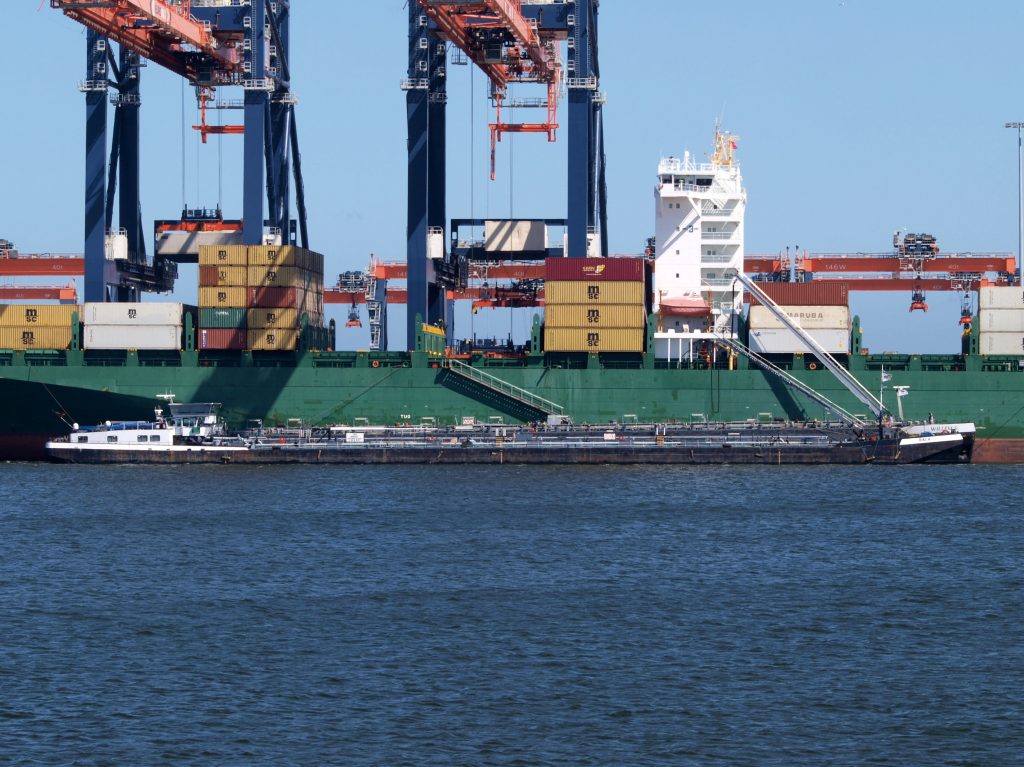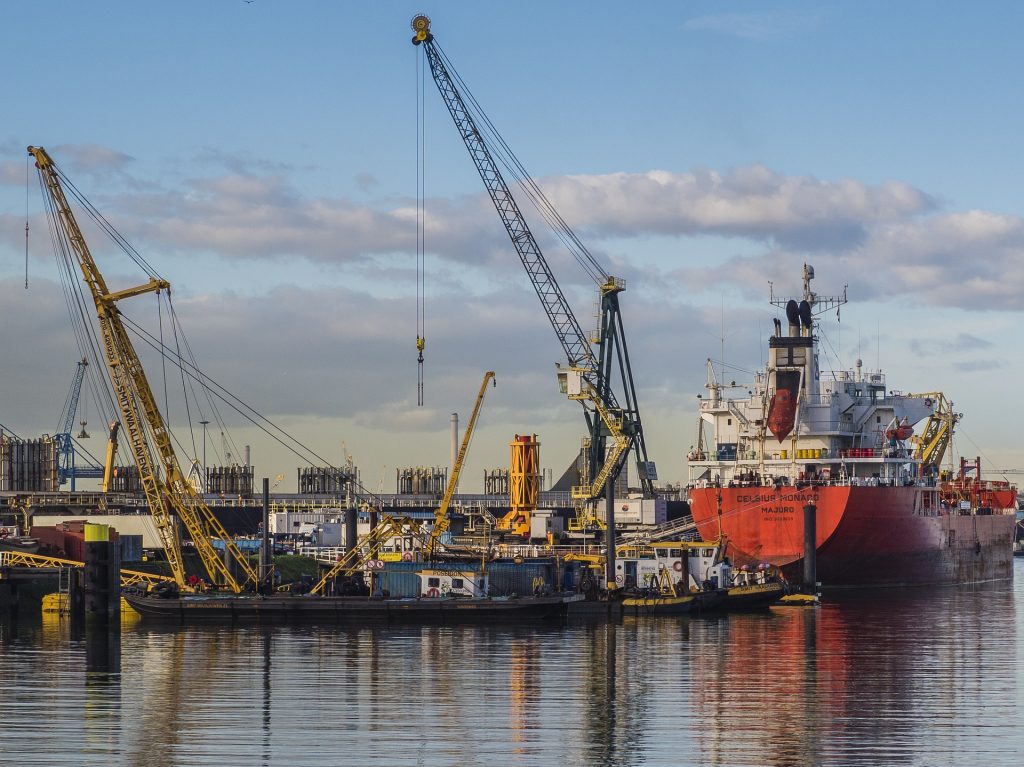Ports have a relationship with their urban environment; they transship goods that are destined to the local market and that are consumed by inhabitants of the nearby cities, they help create employment and economic activity directly and indirectly [1], but they also burden their environment with external costs including emissions, noise and use of scarce space. Merk argues [2] that ports have a positive impact on their hinterlands, which can reach inland hundreds of kilometers, while most external costs are borne by the direct environment, the city.
While considering the balance between (external) cost and benefits of the port for the city, the sustainability of the port comes into play. Ports can be referred to as “sustainable” for various reasons, including that port operations and industrial activities in the port are more environmentally and socially benign, that the connecting seaside (foreland) and landside (hinterland) logistics networks make use of environmentally friendly modes of transportation, or that the production and use of energy in and around the ports is based on renewable sources. The port may even seek an active role in the circular economy by hosting industrial or logistics activities that contribute to circular processes such as environmentally conscious recovery of materials, components and products [3].
Sustainability of ports recognizes roughly two types of scopes. The first type of scope refers to the nature of the external costs or benefits in play, the second type of scope to the system boundaries taken into consideration. For GreenHouse Gas (GHG) emissions, for instance, the GHG protocol [4] specifies the emissions that are referred to as GHG and that are expressed in carbon-equivalent units, while the second scope identifies the system boundaries, such as company, supply chain, product, project, and port area or city. The outcomes of a Life Cycle Analysis for products often depends on the system boundary taken into consideration; when emissions of production are considered, cane sugar consumed in Europe may have a lower footprint than locally produced beet sugar, despite maritime transport required to bring the product from South America. For ports, the scopes under consideration may vary. For the second type, a narrow scope would involve external costs that originate from processes in the port area, thus excluding transportation from and to the port area. Including transportation from and to the port has even a global coverage, and is currently progressed by a number of ports. For instance, the Environmental Ship Index (ESI), initiated by a number of global ports, scrutinizes vessels that call upon ports on their global emissions [5], while also the IMO is developing its strategy toward 50% emission reduction worldwide for seagoing vessels by 2050 [6]. These scopes do not include the complete life cycle of products which are being transported and transshipped through ports.
For containerized cargo, such scope may be argued to be irrelevant to ports. When containers, i.e., the standardized loading units used in maritime transport, are transshipped in the port, the nature of the cargo inside is known only to a few parties. Port operators, who handle the containers at their port terminals, for instance, are usually not informed about the contents of the containers. One can argue that for such parties, there is not an immediate need to be provided with the bill of lading specifying the goods, and they may even choose not to be burdened with it for liability reasons in the case of cargo theft. Also, port authorities are happy to publish the amount of steel boxes that have handled in their port area on a yearly basis, together with tonnages of the main commodities that have been transshipped. Detailed statistics on the various types of containerized cargo is usually not published and is apparently either deemed not relevant, considered sensitive information, or simply unknown. There are signals that this is changing, and perhaps rapidly. Port operators seem progressively interested in the nature of the cargo and seek customer intimacy with shippers. For example, global port operator DP World has initiated “Digital Freight Alliance”, leveraging its asset base by providing a global freight forwarding network on a platform, supported by its freight forwarding partners. Its platform service “Cargoes Flow” provides cargo tracking and tracing capabilities to shippers. Also, deep sea liner Maersk, together with digital solutions provider IBM, developed “Tradelens”, a blockchain powered platform on which supply chain visibility solutions are offered. Although focus is on containerized trade, the ultimate value of such information services is reaped at the cargo level.
Enforcement agencies, such as customs and consumer product safety authorities, always had a keen interest in imports and exports in ports at the cargo level. The introduction of the maritime container as a standardized loading unit for cargo created a higher dependency on information systems for surveying goods upon import and export. Confidence in the information about the contents of a steel box is created by supply chain intelligence. Inspection of all cargo that goes through a port is impossible, so profiling container data informs the blocking of a small fraction of containers for closer inspection by means of x-ray scan or ultimately by opening the box. To avoid false positives (legitimate trade is inspected) or false negatives (illegitimate trade is not inspected), the reliability of data used for profiling is key. One way to achieve higher levels of confidence in data from import and export declarations is by having corroborating evidence that the supply chain at hand is in control by legitimate parties. Customs proposed supply chain parties to organize a data pipeline, a supply chain visibility system, where operational data from supply chain systems could provide such evidence [7].

Making sure that illegitimate trade does not cross borders is an important societal interest and in the interest of citizens, which is obvious for drug and human trafficking. Interestingly enough, the definition of illegitimate trade has shifted. The importation of hardwood for which no sustainable harvesting certificates can be presented, is illegal. This requires importers to check whether the sourced product originates from a legitimate source, i.e., logging not associated with deforestation. But for legitimate trade, there are also restrictions with regard to the validity of certain sustainability claims. Importers that claim their product to be organic and are labeled with the EU organic logo need to follow guidelines, which are enforced by the appropriate authorities.
Validation of sustainability claims is closely related to supply chain visibility. The imported or exported product itself may not reveal its sustainability footprint: inspection of the product characteristics is not likely to reveal whether the product is produced under admissible working conditions, smallholder farmers have sufficiently been compensated for their harvest, the actual carbon footprint coincides with the reported one, and so on. Such sustainability claims need validation through reliable and accurate information generated throughout the supply chain. In other words, supply chain visibility (information is available to the relevant supply chain partners) and transparency (relevant information is provided to external stakeholders) is required.

Information technologies such as Blockchain are oftentimes put to the forefront as killer applications that allow supply chains to be visible and transparent. In most cases, product providence, for example, is said to be achieved through tracking and tracing solutions throughout the supply chain. Such technologies indeed provide interesting opportunities, but the structure of the supply chain plays an important role here. Supply chains can be very complex, for instance when there are many tiers of suppliers involved (multiple-step outsourcing of production steps to contractors), when some of the supply chain processes and supply chain relationships are not well-defined (informal trade in harvested produce upstream the agricultural supply chain), or when products get mixed (certified with non-certified products can be mixed at facilities to achieve economies of scale). Complex supply chains may not admit straightforward tracking and tracing solutions, so in such cases, other so-called Chain-of-Custody options are to be considered. For example, in case one cannot avoid mixing of certified and non-certified produce, chain-of-custody type “Mass Balance” can be applied which does not track and trace produce, but ensures that the amount of product with sustainability clams is offset by produce that is sourced and processed to obtain that amount of product in a sustainable fashion.
It turns out that connecting sustainable production to consumer willingness to pay for sustainable products is difficult. The understandability and credibility of product logos is problematic, as incidents reveal [8]. Also national authorities are struggling with enforcing sustainability requirements on imports [9]. This has a lot to do with supply chain visibility and transparency: How can the buyer of a product downstream the supply chain acknowledge that the purchased product is sustainable? How can sustainability claims be validated? These questions need answers when products enter the market and this happens at the port. The port is the gateway of the world to local markets and vice versa. Its activities, vital to the local economy, also cause external costs borne by the port-city. At the same time, products consumed by local citizens cause external costs elsewhere in the world, usually at the places where the products are produced. The port has thus a role to play in overseeing import and export of products that are transshipped in the port, as currently done by Customs and other authorities. Sustainable ports have been able to better balance the pros and cons of its activities, and the ability to scrutinize its throughput at the cargo level for sustainability aspects will bring this to the next level.
It will require ports to better understand the supply chain they are involved in, namely at the cargo level. For commercial reasons, port players have already started to grow their interest in global trade at the cargo level, either to create value in the corresponding supply chains or to commit the cargo flows to their assets. With the increasing interest in sustainability aspects by governmental and non-governmental organizations, investors, shippers and consumers, such value will be expressed progressively in terms of social and environmental responsible activities. This puts these values at the core of port performance, and ports that are able to demonstrate sustainability of their throughput at the cargo level create a competitive advantage.
Head Image | AMPT Terminal by night. (© Danny Cornelissen; Source: Port of Rotterdam Authority, 2020).
Notes
[1] Bart Kuipers (2018) Het Rotterdam effect: De impact van de Rotterdamse mainport op de Nederlandse economie, UPT Erasmus.
[2] Olaf Merk (2013) The Competitiveness of Global Port-Cities: Synthesis Report, OECD Regional Development working papers 2013/13.
[3] Several of these sustainability aspects are highlighted in the Port Vision 2030 document of the Port of Rotterdam, accessible via https://www.portofrotterdam.com/en/.
[4] See: https://ghgprotocol.org/.
[5] See: https://www.environmentalshipindex.org/.
[6] See: www.imo.org/en/MediaCentre/PressBriefings/pages/DecadeOfGHGAction.aspx/.
[7] See for example: David Hesketh (2009). Seamless electronic data and logistics pipelines shift focus from import declarations to start of commercial transaction. World Customs Journal 3(1): 27-32.
[8] There are quite a few cases in which high-end brands are confronted with malpractices in their supply chains, among which the Rana Plaza collapse of an illegal textile factory where items of leading fashion brands were found on site) or in which certifying organizations are confronted with malpractices associated with their certified product (Better Cotton is struggling with its Mass Balance chain of custody after certified product had been associated with Uygur forced labor in China).
[9] For example, import of illegal timber by Dutch importers did not result in prosecution, which caused the Dutch Food and Consumer Product Safety authority to be scrutinized by NGOs; see: https://www.nrc.nl/nieuws/2020/01/28/doet-nvwa-genoeg-tegen-importeurs-illegaal-hout-a3988479/.